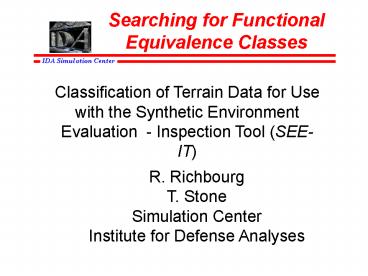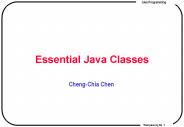Searching for Functional Equivalence Classes
1 / 22
Title:
Searching for Functional Equivalence Classes
Description:
Permit visual inspection and query. Initially applied to ... specification of geometric properties and interactions involving object ... exist for 'AZ' or 'BZ' ... –
Number of Views:59
Avg rating:3.0/5.0
Title: Searching for Functional Equivalence Classes
1
Searching for Functional Equivalence Classes
Classification of Terrain Data for Use with the
Synthetic Environment Evaluation - Inspection
Tool (SEE-IT)
R. Richbourg T. Stone Simulation Center Institute
for Defense Analyses
2
Background
- SEE-IT is designed to evaluate and inspect
digital terrain data - Two primary uses
- Locate and describe potential data anomalies
- Permit visual inspection and query
- Initially applied to S1000 format data
- Now consumes SEDRIS transmittal files
3
What is the Need?
SEE-IT will be applied to data of disparate
origin and intended use SEDRIS Data
Classification Standard (SDCS) can identify 700
unique objects and 1300 object attributes Evaluati
on operations will probably include some that are
uniquely important for each end-user (and are
very difficult to predict at this point)
SEE-IT must provide for dynamic specification of
operations that could pertain to a large set of
objects
4
Some Terms
- Taxonomy - A theoretical science that studies
principles, laws, and methods of classification
and identification - Classificatory System - A system that results
from the process of classification - Taxon - A group or category in a classificatory
system (plural taxa) - Axis - A functional perspective or reference to
define taxa - SCC (SEDRIS Classification Code) - A label that
describes the functional type of an object
instance - Unit - An individual SCC that is a member of
some taxon - Object Instance - A data element described by a
specific SCC
5
What is the Desired End State?
Incorporate into SEE-IT a classificatory system
with appropriate taxa that will permit the
efficient specification of units to be used
during Dynamic specification of geometric
properties and interactions involving object
instances Dynamic specification of object
instances during data query and display
This does not seem to be a novel requirement -
shouldnt some extant system meet these stated
needs?
6
The DIGEST Classificatory System
7
An Example Use
Locate all intersections between object
instances from the taxon ltLand Transportationgt
and the taxon ltHydrographic Featuregt except those
that occur coincident to the location of an
object from the taxon ltBridgegt
Bellevue, Washington
8
Units Involved
ltLand Transportationgt AL210 Snow Shed AN010
Railroad AN050 Railroad Siding AP010 Cart
Track AP030 Road AP050 Trail AQ010 Aerial
Cableway AQ070 Ferry Crossing AQ130 Tunnel AZ010
Railroad Nexus AZ030 Road Nexus AZ060 Rail Yard
Nexus GA035 NAVAIDS
ltHydrographic Featuresgt BA010 Coastline BA020
Foreshore BA040 Water BH010 Aqueduct BH020
Canal BH050 Fish Farm BH080 Lake/Pond BH130
Reservoir BH140 River/Stream BH190 Lagoon/Reef
Pool BZ010 Aqueduct Nexus BZ020 Canal Nexus BZ080
Lake Nexus BZ130 Reservoir Nexus BZ140 River
Nexus
ltBridgegt AQ040 Bridge AQ064 Causeway
9
Performance Problems
- In total, 11 DIGEST taxa (containing 84 units)
must be referenced to select the 34 desired units
- a perfect system would feature reference to
only 3 taxa which included the 34 desired units
and no others. - Have to examine 84 individual units when only
164 exist in total - No DIGEST taxa exist for AZ or BZ
- Need to search through taxa with less
suggestive names (such as ltCulture -
Miscellaneous Featuresgt) - Tally assumes no wasted effort
- Not the worst example - checking the mobility
attribute consistency of object instances
involves 78 units found in 23 taxa (containing
141 units in total)
10
SEE-IT Operations
- Geometry - duplication, size, composition
- Topology - vertical or horizontal tears, T
vertices, coverage - Feature Interaction - Transportation features
should not intersect other features in ways that
preclude mobility - Static Models - placement, composition, special
cases - Query Operations - by type, attribution,
geometry, location
Implies that, for each object instance, we need
to be aware of the intended geometry, the layer
(or strata relative to other object instances),
and the functional identification.
11
Taxon Unit Assignments - Dynamic or Static?
AQ040 Bridge / Overpass AQ041 Engineering
Bridge AQ045 Bridge Span AQ064 Causeway AQ112
Breach Point / Lane AQ130 Tunnel BH070 Ford
Should taxon members be statically defined or is
this something that must be determined on a case
by case basis?
There are several contextual influences that have
direct and fundamental implications
12
An Example
The SDCS includes SCC BI020 (Dam/Weir)
13
A Closer Look
A major roadway travels across the top of the
Dam Should it be classified along with bridges
or roadways? Should all dams be grouped with
bridges? Should every bridge be classified as a
dam?
14
A Second Example
BH080 Lake/Pond BB190 Pier
15
Same Lake, Another Time
Should every seaplane base (GB065) be grouped
with open water? Should associated NAVAIDS be
identified as Nautical Obstructions (BD070)?
16
A Van Wyck Expressway Overpass
AQ040 - Bridge or Overpass
17
JFK Airport
The overpass is also a taxiway (GB075) Which
usage is most important? How should it be
positioned in the classification?
18
MODSAF at Camp Pendleton
Result of a TEC exercise using ModSAF in an area
where SEE-IT reported potential terrain problems
19
Context ...
One systems error ...
is another systems design.
20
The SEE-ITClassificatory System
ltConfigurationgt Area Directed Line Footprint
Model Line Point Feature Point Model Polygon Dynam
ic Model Grid
ltStratumgt Applique Coverage Inactive Sub-Surface S
urface
ltDomaingt Air Mobility Weather Air Obstacle
Descriptive Boundary Terrain Bridging
Vegetation Land Culture Inland Water Land
Mobility Military Use Land Obstacle Open
Water Maritime Mobility Space Maritime
Obstacle Maritime Culture
21
Comparative Performance
DIGEST
SEE-IT
22
Results
- Classificatory system development seems simple
- it is not! - Context comes in different types and each has
fundamental influence - A specific classificatory system, but, there
is no single criterion for classification in any
field - A general methodology
- are classificatory system benefits applicable?
- does any existing system suffice?
- exemplified functional metrics to measure
applicability - experimental method to provide measurement
- exemplified experiment performance influences
design































